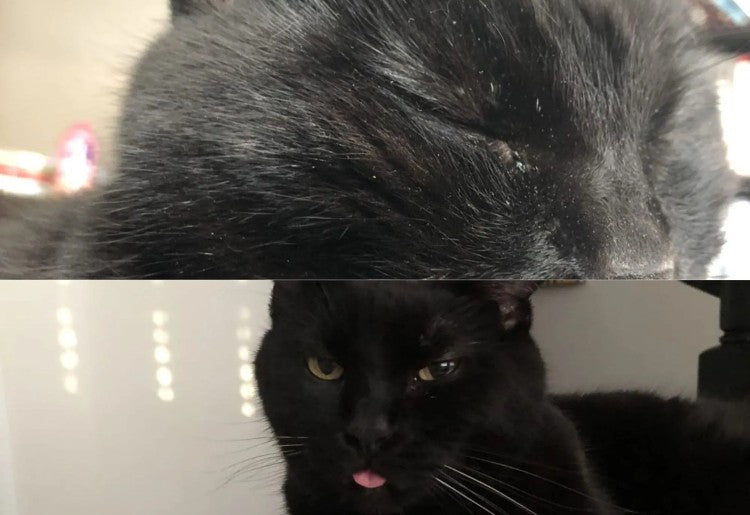Type:
Intensive Paw Conditioner For Dogs & Cats
Type:
Tear Stain Remover Powder for Dogs & Cats
Type:
Intensive Nourishing Shampoo For Dogs & Cats
Type:
Tear Stain Remover Solution for Dogs
Type:
Tear Stain Remover Powder for Dogs & Cats
Type:
Intensive Nourishing Shampoo For Dogs & Cats
Type:
Intensive Paw Conditioner For Dogs & Cats
Type:
Flea & Tick Shampoo For Dogs & Cats
Type:
Biogreen Enriched Shampoo For Dogs & Cats
Type:
Intensive Nourishing Shampoo For Dogs & Cats

PawPurity — Makers Of Naturally Top Grade Pet Products
Lisa has worked to keep animals and their companions healthy, happy and safe for more than 13 years. Before it became commonplace, she established an online pet-friendly travel service – Pet Hotels of America. Lisa became known as the pet travel expert and was published in newspapers and magazines throughout the country.
Growing up, dogs and cats were always part of her family. As a native Californian, protecting her pets from fleas and ticks took precedence, but the treatment options were limited. Her pets made it clear they did not like the vet-recommended spot-on repellent. When one of her dogs got extremely ill after, it became apparent to her that animals around the world needed a better solution other than pesticides and chemicals to keep them safe from pests.
She was not the only one. Many community residents had the same concerns. She began researching what the FDA was doing about these products and what ingredients other countries had banned in pet grooming products that the U.S. continued to allow. What she discovered horrified her. A change needed to be made.
Now she provides animal owners with natural products so their pets don’t need to be subjected to potentially harmful chemicals, poisons, detergents, artificial fragrances, and such preservatives as formaldehyde. By developing 100% natural safe pet grooming products from shampoos to flea/tick treatments to healing paw conditioners, she hopes to change how pets are cared for to improve and prolong their lives.

100% Natural & Organic Dog & Cat Grooming Products
After a lifetime of dog and cat ownership, PawPurity has developed a line of natural and organic grooming products, formulated to keep our pets’ skin, coat, paws, eyes and noses healthy without chemicals. Join us in experiencing 100% natural!

Free shipping
on orders of $75 or more

Easy Returns

Shipping to Canada & US
Blog posts
Cat Dermatitis – Causes & Cures
Are you a cat parent trying to figure out what is causing your sweet little kitty’s skin irritation? If so, you may be dealing with dermatitis – an inflammation caused most often by allergies. Thankfully, this common issue can usually be managed and cured at home with the help of natural and/or medicinal antibiotics and topical creams. In this blog post, we will discuss some common causes of cat dermatitis and various treatments that could provide relief for your feline friend. What is Dermatitis in Cats? According to Canadian Veterinary Journal, cat dermatitis is an allergic reaction in dogs and cats. It is also termed Atopic Dermatitis or, more generally, skin allergies of cats. Cat dermatitis is a condition in which the skin and fur of cats become inflamed, often resulting in redness, itchiness, and scaly bumps or lesions. The condition has several potential causes, including bacterial or fungal infections, allergies to food or environmental hazards, parasites like fleas or mites, or even underlying medical conditions such as diabetes or kidney disease. Diagnosis typically involves a history of the animal’s symptoms and lifestyle and may be supplemented with blood tests and imaging to rule out secondary causes. As far as epidemiology is concerned, cat dermatitis can occur at any age but is more common in younger cats than in older ones. Poor grooming habits can also increase risk as more bacteria accumulate on the skin’s surface. Treatment depends on the exact cause but often includes nourishing shampoos and topical ointments along with changes in diet and increases in hygiene care to help reduce irritation. Types of Dermatitis in Cats Like all other species, cats can be affected by various skin conditions. Dermatitis is one of the more common issues, and there are three distinct forms: allergic dermatitis, parasitic dermatitis, contact dermatitis, and several food allergies. Allergic dermatitis Allergic dermatitis is generally caused by an immune system reaction to allergies; this may manifest as dry or itchy skin and hair loss. Parasitic dermatitis Parasitic dermatitis often thus arises from flea bites or mites; symptoms typically appear on the head, neck, or back and may include reddened skin or scabs. Contact dermatitis Contact dermatitis originates from exposure to irritants such as certain types of shampoos or detergents; here, it is important to identify the trigger so the cat can receive proper medical attention. Food Dermatitis Food dermatitis is a common health problem seen in cats with an allergic reaction to a certain food or ingredient they’ve ingested. It’s important for pet owners to be aware of the signs of this condition so that they can get their furry friend the help they need as soon as possible. Cats may present several different physical symptoms when suffering from food dermatitis, including excessive scratching and itching, redness or swelling on their lips and around their eyes, and inflamed skin lesions or bumps. Solar Dermatitis Solar Dermatitis in cats is an inflammatory skin condition caused by direct sun exposure. It is often seen in lighter-colored cats or cats with thin fur coats due to increased vulnerability to the ultraviolet radiation of the sun. Symptoms can range from sunburn or itching to crusting and hair loss on exposed areas of the body such as the ears, nose, unprotected areas of legs, nipples, and all other parts which are not covered by fur. Miliary dermatitis Miliary dermatitis in cats is a distressing condition that causes extreme itching and coat loss. It has no single cause and is linked to an allergic hypersensitivity reaction of the skin. However, the trigger can vary greatly. To diagnose miliary dermatitis, a veterinary doctor must assess your cat’s symptom presentation. It is imperative that cat owners recognize these types of dermatitis in their cats to promptly address them with prescribed medical treatments. Causes of Cat Dermatitis There are a variety of causes for this condition, the most notable being allergies to environmental substances such as pollen, dust mites, or insect bites. Other causes include bacterial or fungal skin infections, exposure to certain insecticides or cleaning products; nutritional deficiencies; flea infestations; metabolic disease; hormonal imbalances; exposure to toxins; mange mite infection, or chronic stress. It’s important to remember that cats with existing health problems are more prone to developing dermatitis due to weakened immune systems. To identify the underlying cause of your cat’s symptomatic dermatitis, it will be important for veterinarians to consult your pet’s medical history and perform several diagnostic tests, including allergen testing, skin biopsies, or blood tests. Signs of Feline Dermatitis It’s easily recognized by the presence of redness, itching, scabbing, crusty bumps, and hair loss on the cat’s skin. Other signs to look out for include the following; persistent licking scratching at one particular spot darkening or discoloration of the affected area thickening or scaling of the skin bald patches. barbering (hair pulling) noticeable lesions In more severe cases, you may observe pus-filled sores and wounds on the paws or elsewhere on the body. If you suspect your cat has signs of feline dermatitis, it is important to take them to a vet immediately, as treatment options should be determined based on the underlying cause. How is Cat Dermatitis Diagnosed? Cat dermatitis is typically diagnosed by a veterinarian observing your cat’s visible symptoms and taking a full medical history. It can also be helpful for the veterinarian to perform some additional tests, such as; blood tests urine tests skin scrapings patch testing fur plucks skin swabs fecal analysis biopsies The information gathered from these tests can help the vet to make an accurate diagnosis. For severe cases of dermatitis, further tests may be necessary to rule out other underlying causes of skin problems. This helps the veterinarian formulate the best way to treat your fur baby’s cat dermatitis so they can get back to feeling happy and healthy in no time. Treatments for Cat Dermatitis Cat dermatitis is a relatively common condition in cats, typically triggered by flea bites and other allergies. While most cases can be alleviated with simple lifestyle adjustments, more severe conditions may require additional treatments. Diagnose and eliminate the allergens Non-chemical, organic shampoos are crucial to providing cat allergies and dermatitis relief Eliminating allergens has long been a mainstay in treating dermatitis in cats. So often, the causes are the chemicals in cat grooming products. Helping your cat find relief may be as simple as changing shampoos to one that is natural with healing ingredients such as nettle leaf, red clover, aloe vera etc. Also, simple environmental and dietary changes can help reduce the number of irritants that come into contact with your cat’s skin and relieve symptoms of this skin disorder. By cleaning carpets and furniture more often, using hypoallergenic litter boxes and detergents, regularly grooming your pet with aa non-chemical shampoo, switching to grain-free or hydrolyzed food products, and removing any plants within the house, you can lessen the effects of the allergens for cats. Furthermore, if you have determined what specific substances may be triggering your pet’s allergies, avoiding contact with those items is also advised; learning what is causing their reactions helps tremendously in getting their itchiness under control. Dermatitis is an uncomfortable condition for felines, but by managing the allergen levels in their immediate environment, it can be treated successfully. Antihistamines and corticosteroids Additionally, antihistamines and topical corticosteroids are often prescribed to reduce symptoms such as itching. However, these medications must be carefully monitored for potential side effects and used only under veterinary supervision. Antihistamines help to reduce the allergic response, while corticosteroids reduce inflammation and itching. Both have unique benefits, so it’s important to discuss these options with your vet before administering any medications to your cat. It is also important that you carefully follow the instructions given by your veterinarian when administering these medications to ensure a successful outcome. Oral antibiotics Oral antibiotics are a common treatment for feline dermatitis; when administered properly, they can control secondary bacterial infections. However, appropriate antibiotic therapy must be determined according to the suspected or identified causative agents. Though the drugs used to treat cats’ skin infections are similar to those used in humans, the dosage and duration of treatments involve veterinary expertise. For best results, it is important to adhere closely to instructions regarding administration frequency, amount, and length of treatment. Besides being effective against contagious bacterial dermatitis, systemic antibiotics also reduce inflammation, resulting in a quicker resolution of clinical features and minimizing the risk of recurring episodes. Medicated and organic shampoos An oft-overlooked part of this care is choosing the right shampoo. Thankfully, many options are available. Organic shampoos may provide fast-acting relief without introducing chemicals into their cats’ environment. If your cat goes outdoors and is subject to fleas and ticks, there are non-chemical repellent shampoos available at PawPurity. Dietary supplements Dietary supplements are an important part of managing feline dermatitis; they help support skin health and reduce inflammation. A vet-approved multivitamin with fatty acids is one of the best options – fatty acids promote healthy cellular walls while providing your pet with a wide range of vitamins and minerals. Additionally, supplements that contain ingredients such as turmeric, evening primrose oil, and omega-3 fish oil can be beneficial, as they all help to alleviate dermatitis signs such as itching or flaking skin. When choosing a supplement, always look for one produced by a reputable manufacturer that has identified dosages for cats on labeling to ensure you are giving your pet the correct amount. Finally, consult your veterinarian before starting any nutrition regimen – their expertise is essential in helping you provide adequate care for your cat’s skin condition. FAQs Is cat dermatitis contagious? Cat dermatitis, or inflammation of the skin, can cause a variety of discomforts like itching, redness, and scaling. But is it contagious? There is no evidence that suggests it is contagious between cats, although some infections causing cat dermatitis can be spread from cats to humans. This means that if your cat has been diagnosed with an infectious form of cat dermatitis, protecting yourself and other members of your household should be a priority. Is dermatitis in cats painful? Dermatitis, an inflammation of the skin, can be painful and uncomfortable for cats. As with other animals, cats experience various symptoms, including irritation, redness, itching, and skin dryness. In extreme cases, they may suffer from deep sores or ulcers and an intense burning sensation. It is important to recognize the signs early and visit your veterinarian for treatment to avoid unnecessary suffering. The expert advice from a vet, combined with proper care, nutrition, and hygiene, will ensure that cats remain healthy and happy despite dermatitis. How long does cat dermatitis last? The duration of cat dermatitis depends on the underlying cause and how prompt treatment is given. With early diagnosis, effective anti-inflammatory medication, plus environmental modifications if needed, it is possible to reduce the severity of the flare ups and manage any chronic symptoms over time. Also, in some cases where there is an underlying infection or parasitical cause involved, the full recovery from cat dermatitis may extend for weeks or months, depending on the specific condition prescribed treatment plan. Final Words In conclusion, cat dermatitis is a common skin disorder that can be uncomfortable for cats and their owners. Knowing the various types and causes of the condition and how to treat it can help alleviate its symptoms and keep your cat healthy. It is important to note that prevention is always better than cure, so make sure to minimize potential triggers such as fleas or allergens in your home. Furthermore, regularly monitoring your cat’s skin will help you catch any issues before they become serious.
Learn moreSkin Mite Dermatitis in Cats – Causes, Symptoms & Treatments
Skin mite dermatitis in cats is a common condition that can be caused by skin mite bites. Skin mite dermatitis in cats, also known as scabies, is caused by an infestation of microscopic parasites called skin mites. It is characterized by intense itching, hair loss, and red, scaly skin. If left untreated, skin mite dermatitis can cause significant discomfort for cats and even lead to secondary infections. In this blog post, we’ll discuss the causes, symptoms, and treatment of skin mite dermatitis in cats and some preventative measures to help keep your cat safe from skin mites. What are skin mites? Skin mites on cats are tiny parasites that are highly transmittable. So even cats with no signs of skin mite dermatitis may be carriers. Treatment for skin mite dermatitis in cats usually consists of topical medications such as medicated or natural shampoos and sprays, oral medications, and changes in diet and environment to reduce the chances of recurrence. PawPurity’s Flea & Tick Spray has proven successful for this even though it was originally formulated for dogs. Causes of Skin Mite Dermatitis in Cats These tiny mites feed on the oils and proteins found in their hosts’ skin and can cause an itchy, red rash. In cats, skin mite dermatitis is typically caused by either Cheyletiella or Otodectes cynotis mites. Cheyletiella mites live in the outer layer of the skin and can cause an intensely itchy rash. The rash appears as small, red bumps that may ooze a thick, yellow-white fluid. Otodectes cynotis mites live in the ear canal and cause severe itching, redness, and crusting around the ears. Both mites can be spread from animal to animal, so cats need to be kept away from other pets with skin mite dermatitis. These parasites are found in environments with low ventilation and improper or insufficient hygiene; thus, overcrowding, infrequent cleaning, and a damp climate are often contributing factors. In addition to these environmental stressors, underlying allergies may create favorable conditions for these skin mites. Once infected, cats typically exhibit symptoms such as fur loss, scaly patches on the skin, redness, and itchiness that can become severe if not treated promptly. How Do Cats Get Mites? Cats can acquire skin mites from their environment or contact other animals. For example, fleas, ticks, and other external parasites can carry mites and spread them between animals. In addition, cats also can contract skin mites by sharing grooming supplies, bedding, or other items that harbor the parasites. Once a cat has acquired skin mites, it is important to act quickly. If left untreated, skin mite dermatitis in cats often leads to more serious health problems such as infection, secondary bacterial infections, and even anemia. This is why seeking prompt medical attention and implementing an effective skin mite treatment for cats is important. Symptoms of Skin Mite Dermatitis in Cats The most common signs of this condition include: excessive scratching biting and licking of the affected area hair loss redness inflammation crusty or scaly skin small pimple-like bumps on the skin In addition, cats with skin mite dermatitis may develop an unpleasant odor from the oils produced by the mites. This parasitic attack on a cat is highly uncomfortable. Diagnosis of Skin Mite Dermatitis Diagnosing skin mite dermatitis in cats may be challenging due to the wide range of symptoms and signs that can be present. To make an accurate diagnosis, a veterinarian will first take skin scrapings. Blood tests may be taken to help determine the presence of mites. If skin mites are detected, the veterinarian will discuss the best treatment plan for the cat. Treatment options may include oral medications, topical ointments, natural repellent shampoos, or injectable medications. Depending on the severity of the infestation, more than one type of medication may be prescribed. Owners need to keep in mind that skin mite dermatitis in cats can take some time to treat and eliminate. Even after all the mites are gone, some cats may experience skin irritations and itching. In these cases, the cat may require a more frequent bathing schedule using an organic repellent shampoo that is gentle on the skin, but effective enough to keep parasites at bay. Treatments for Skin Mite Dermatitis Treating skin mite dermatitis in cats typically involves a combination of medical and environmental management. It is important to reduce the exposure of the cat to mites and prevent further infestation. 1. Medical Treatments Medical treatment usually involves a prescription topical or oral medication that kills mites. Topical medications are usually applied to the affected area of the skin, like organic flea and tick shampoos, while oral medications are usually given as tablets or capsules. Depending on the severity of the infestation, your veterinarian may also recommend treating all cats in the household with appropriate anti-parasite medication and/or flea and tick-repellent shampoo to prevent re-infestation. 2. Environmental Management In addition to medical treatments, reducing exposure to mites is also important for successful treatment. This includes frequent vacuuming and cleaning pet bedding, furniture, and carpets; washing and disinfecting cages and litter boxes; and frequently misting the cat with dust mite deterrent sprays. 3. Diet and Hygiene It is also important to keep up good hygiene practices, including regular brushing and combing to remove debris from their fur and skin. Additionally, providing healthy nutrition and plenty of access to clean water can help boost cats’ immune systems, which can help fight off mites. By combining environmental management and regular bathing with repelling shampoos, skin mite dermatitis in cats can be avoided. However, if you think your cat may already have skin mite dermatitis, consult your veterinarian to discuss treatment options. Can You Get Skin Mites from Cats? The answer is yes; you can get skin mites from cats. Skin mites are easily transferred to humans and can cause skin irritation. However, skin mites are not transferable between humans; however, it is still possible for the mites to be transferred from cats to humans. To reduce the risk of transfer, wash hands after handling an infected animal and wear protective clothing when encountering pets. Additionally, ensure that all areas of the home are cleaned thoroughly and regularly to limit the spread of skin mites. How to Prevent Skin Mites in Cats? One of the best ways to prevent skin mite dermatitis in cats is bathing it at least once a month with a repelling shampoo. Brushing cats regularly helps to keep the fur clean and free from parasites. Look for signs of irritation or itching, which is a possible mite infestation. In addition to regular grooming and monitoring, keep cats’ environments as clean and free from allergens as possible. Allergens such as dust and pollen can aggravate an existing case of skin mite dermatitis, so keep the home environment needs to be free from these agitators. Keep cats away from other animals, especially those with fleas or other parasites. Following these simple tips can help keep cats safe from skin mite dermatitis and ensure they stay healthy and happy. Final Words In conclusion, skin mite dermatitis in cats is a common condition that can be caused by various environmental factors and can lead to severe irritation and discomfort. Knowing the symptoms and cause of skin mite dermatitis can help identify the problem and take the necessary treatment steps. With the right approach, skin mite dermatitis easily can be managed with lifestyle changes. At times, professional veterinary services may be necessary.
Learn moreWhat Shampoo is Safe to Use on Cats?
You may think that any shampoo would be safe when it comes to cleaning your cat, but that’s not the case. Different shampoos have different pH levels, which can impact a cat’s skin. They also may have ingredients that irritate your furbababies. It’s essential to use a shampoo specifically designed for cats. In this article, we’ll share with you what ingredients in shampoos are safe for your feline friend and what is not. How do Dog and Cat Shampoos Differ? We get this question a lot of times, as cat owners what to know what is the difference between cat shampoos and dog shampoos? People tend to believe that both are furry animals and that what works for their dogs would also work for the cats. But that’s not necessarily true. Dogs have hair; cats have fur. There are many reasons why cat shampoos differ from their canine counterparts. For one thing, cats are much more sensitive than dogs regarding chemicals and artificial fragrances. This means that you must be careful when choosing a shampoo for your feline friend, as many of the ingredients in dog shampoos can be irritants for cats. Another difference is that most cats tend to have shorter fur than dogs do hair, so their shampoos don’t necessarily need to be super thick. This means they are easier to rinse. And since most cats would rather avoid being bathed, this is a good thing. Finally, cats have softer and more sensitive skin than dogs. Therefore, it is essential to stay pet-specific while choosing shampoo products unless the label states it is formulated for both cats and dogs. What to Look for in a Cat Shampoo There are thousands of commercially available shampoo brands for cats, but only some of them you can rely on for making your cat’s skin healthy and the coat shiny. So before buying a shampoo for your cat, consider the following; The ingredients should be safe for cats specifically and should say it on the bottle. This is the most important thing to look for in a cat shampoo. Avoid harmful chemicals or nasty preservatives such as formaldehyde, the leading preservative used in US cat shampoos, although it’s been banned in many other countries. It goes under four different names and is slow-releasing, which is how manufacturers include it as an ingredient. When possible, go for all-natural shampoos. They are innately gentler on the skin, healthier for the fur and make for the best cat shampoo. The shampoo should not remove the natural oils from your cat’s fur. Sulfates are a good example of this. Much like a detergent removes oils from pots and pans, sulfates create an unbalanced oil system on your cat. A good shampoo will do more than clean your cat; it will leave your cat’s fur nourished, conditioned and healthy-looking. Look for a shampoo that is easy to use and rinses off without leaving residue. The better shampoos don’t have sulfates, which means they won’t later as well and this is a good thing. Sulfates are not healthy for your cat’s skin so please read the labels. Neither are artificial fragrances, which are produced from petroleum. Below is an example of PawPurity’s Intensive Nourishing Shampoo for Dogs & Cats. It is 100% natural and made with organic ingredients. It has an olive oil base and contains 26 organic herbs, plants and oils. All essential oils are organic and of the highest quality. The ingredients should be safe for cats specifically and should say it on the bottle. This is the most important thing to look for in a cat shampoo. Avoid harmful chemicals or nasty preservatives. When possible, go for all-natural shampoos, as they are innately gentler on the skin. The shampoo should not remove the natural oils from your cat’s fur. A good shampoo will leave your cat’s coat clean, soft, and healthy-looking. Look for a shampoo that is easy to use and rinses off without leaving residue. The better shampoos don’t have sulfates, which means they won’t later as well and this is a good thing. Sulfates are not healthy for your cat’s skin so please read the labels. Safe Ingredients for Cat Shampoos When shopping for the best cat shampoo, prioritize products with safe and natural ingredients explicitly labeled for feline use. Avoid shampoos containing harmful chemicals like sulfates, which can strip away natural oils from the cat’s fur and disrupt the skin’s pH balance. Opt for gentle natural cleansers enriched with ingredients like aloe vera, olive oil, and herbs known for their conditioning,, soothing and moisturizing properties. Steer clear of shampoos with artificial fragrances, dyes, and harsh preservatives like parabens, which can cause skin allergies and other health issues in cats. Instead, choose products free from camphor, phthalates, and other potentially harmful additives. Always check the label for pH-balanced formulations suitable for cats to maintain their skin’s natural acidity and prevent irritation. It will say it on the label. Preservatives like formaldehyde releasers and sodium benzoate should also be avoided, as they can pose serious health risks to cats. According to the ACS’ Journal report of 2018, certain preservatives have been linked to toxicity and diseases in pets, highlighting the importance of selecting safe grooming products. When it comes to choosing an organic shampoo for your cat, you can prefer and look for some of the following good ingredients in the shampoo products: Aloe vera Chamomile Lavender Oatmeal Yucca Red clover Cedarwood Buttermilk Shea butter Coconut oil Olive oil Vitamin E Nettle leaf What Should you Avoid in a Cat Shampoo? You should be aware of a few harsh ingredients often used in cat shampoos. We have listed some harmful ingredients below, but we urge you to read our in-depth article Cat Shampoo Ingredients to Avoid. Avoid pH-Disrupting Shampoos This means it is not too acidic or alkaline, irritating your cat’s skin. A cat shampoo should have an average pH of around 6.46, which differs from a human of 5.84. So always avoid human shampoos for your cats, as they can be slightly acidic. Avoid Artificial Fragrances & Dyes You also want to ensure the shampoo does not contain fragrances or dyes, as these can also irritate. Some chemicals to be avoided are; Alcohols Camphor Parabens Phthalates Stearates Linalool Benzaldehyde Ethyl acetate Avoid Harsh Preservatives There are certain preservatives used in cat products, even by well-known pet grooming brands, that are so toxic and cancerous for cats. Kindly look for the following bad preservatives. Formaldehyde releasers Isothiazolinones Sodium Benzoate Parabens According to the ACS’ Journal report of 2018, preservatives like parabens are toxic and disease-causing in pets. The Takeaway Do your homework about the product you believe to be the best cat shampoo. Ingredients do matter, especially when it comes to cat shampoos. While some seem good for temporary use, they may cause skin and coat issues later. There are a variety of shampoos that are safe to use on cats, but you should know what to look for. If you have any questions or concerns, contact us via chat or email at info@pawpurity.com. Make sure to subscribe to our newsletter where we offer tips on how to keep your cat healthy. Thanks for reading!
Learn more










































